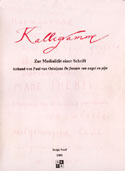
Sonja Neef. 2000. Kalligramme. Zur Medialität einer Schrift. Anhand von Paul van Ostaijen‹s ›De feesten van angst en pijn.‹ Amsterdam: ASCA. (Calligrams: The Mediality of Writing in Paul van Ostaijen’s ›De feesten van angst en pijn‹ (›Feasts of Fear and Pain‹))
Kurzbeschreibung: The text that forms the focus of this book is De feesten van angst en pijn (Feasts of Fear and Pain), a volume of Dutch poetry by Belgian-Flemish avant-garde writer Paul van Ostaijen. These poems are visually striking, for they are printed as a facsimile-print of a hand-written manuscript printed not only in black ink but also in red, blue, purple, and green ink. In addition, isolated words or phrases are distributed over large fields of white. Besides this special visual form — which Neef calls »calligraphic« writing — the strong assonant and rhythmic sound of the poems attracts the reader’s attention. Reading these poems, thus, often resembles the experience of looking at images or listening to music. Calligrams, for this reason, ask for reading strategies beyond the word image opposition and beyond the phone graphe opposition. Because De feesten is written in a very turbulent period, in a Berlin of 1918 to 1921 that was the centre of European avant-garde at that time, Neef also takes a close look at the historical-cultural framing of this poetry. The rise of new media such as the gramophone, the telegraph, photography, and silent films was beginning to influence the established, »old« art of literature. In De feesten, these media are articulated literally, and the calligraphic writing of these poems often imitates other »low« forms of art such as cubist painting, jazz, and silent film. Through an intense dialogue with these poems, Neef intertwines the historical framing of this poetry and a systematical approach of the semiotics of calligraphic writing: its mechanisms and practices of articulation, its double movement of speaking verbally while saying nothing, and its technologies of performing writing visually and audibly. This book is not just a monograph on Van Ostaijen; it is also a critical study of media because it deals with crucial problems of recent media theory.
Contents: 1. Schweigend Sprechen; 2. Interlinearität; 3. Intermedialität; 4. Die Semiotik der Farben; 5. Interdiskursivität. Kodes, Stimmen, Diskurse; 6. Mystische Sprechweisen; 7. Visuell Lesen; 8. Auditiv Lesen; 9. Kinematographisch Lesen
365 pages, several illustrations, 19,90 Euro, available at asca@hum.uva.nl